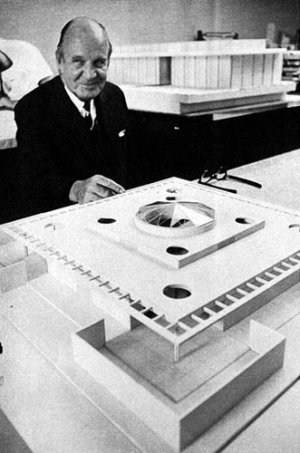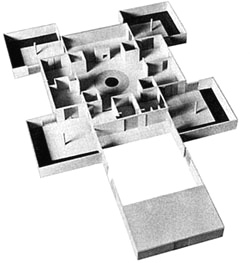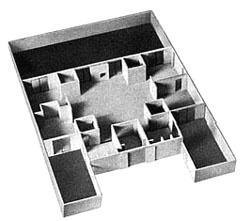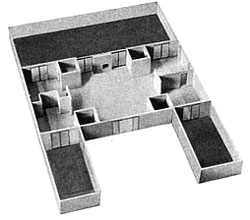|
Architect Edward Durell Stone, whose U.S. pavilion was the
hit of the 1958 Brussels World's Fair, has every reason to be
confidently relaxed about the home he has designed for this World's
Fair. Sharing a landscaped site with a traditional and a contemporary
house in The House of Good Taste exhibit, it will be visited
by more people than any other all-out modern home in history
and may well be the most influential, thought-provoking home
ever built. Shown above is the scale model.
Those who prefer a traditional house might dismiss this one
as too modern. Those who prefer modern design might quickly label
it as too conservative and formal. Both judgments would be hasty.
For, paradoxically, Stone's trend-setter offers a striking answer
to America's most modern problem - the density dilemma - in a
traditional way that dates back to ancient Mediterranean cultures.
The World's Fair House is a three-dimensional dramatization
of Stone's deeply felt convictions about how people will live.
As he explains it: "If the colonies had been settled by
the French or Spanish, we would have fallen heir to a completely
different tradition. The ancient Pompeians, for example, built
their houses wall to wall, presenting a solid front to the street.
Behind this stretched a beautiful atrium (a lighted room) and
an open courtyard with all the rooms grouped around it."
Adapting this idea, Stone created a house that looks inward and
develops its personality from the character of the individual
family. Walls enclose virtually all of the site. Windows look
out on the cloistered gardens that serve as buffer zones between
street and neighbors.
However, our housing traditions are Anglo-Saxon. Our Colonial
ancestors sought to live in the manner of the English country
squire - a freestanding house on a private plot of land. "As
a result," says Stone, "the suburbs of our cities are
today being used up by little boxes set on handkerchief lawns
... which is the most impractical way in the world to build dwellings.
I think we should stop kidding ourselves and recognize that our
land is very precious. We had better cloister our houses and
be less wasteful of it. By building wall to wall, with enclosed
courtyards, we also gain that other precious commodity so essential
to peace and tranquility - privacy."

| (Above) This view of Fair house
model in Stone's New York City drafting room shows square roof
with latticed overhang, central glass dome. Walls to property
lines enclose open courtyards off each corner bedroom. |
|
|
| (Right) These three compact plans
show how the Fair house can be built wall to wall in space-saving
cluster communities without loss of privacy. Center version uses
atrium as living room; bottom, without dining room, is three
bedroom plan. |
|
 |
 |
 |
A Home with Three Plans for
Privacy
Edward Durell Stone's World's Fair House is significant for
two reasons: He tackles the fundamental problem posed by our
soaring population - the need to live closer together. His solution
is a house of beautiful simplicity and style. It centers around
a spacious atrium, a 1,026-square-foot room with a 22-foot faceted
glass dome. (The all-out World's Fair version will include a
6-foot circular reflecting pool.) This is the heart of the home
and the key to Stone's design. All other rooms are planned around
the central core, as shown in illustrations at right. These give
you a clue to the house's versatility, but none to its warmth
and livability.
The real house at the Fair will feature many innovations,
from rugged new white wall paneling on the exterior to oil-finished
teak panels on the interior. It will be handsomely furnished
by decorator Sarah Hunter Kelly, from fine art to a fine kitchen;
landscaped for minimum maintenance by Clarke & Rapuano, with
flowering trees and rose gardens off each bedroom.
Not everyone will find this his "perfect" house.
But all will agree that Stone has designed something exciting
to see and challenging to think about. After all, that's why
we have World's Fairs.
|